-
Posts
563 -
Joined
-
Last visited
aussiesoldier's Achievements
-
The search was on! I have collected European military swords for approximately ten years. Whilst I was lucky enough to purchase a named 1912 cavalry officer’s sword, it took many years to discover its owner. This process set me onto the path of purchasing other named British swords. This sword came to my attention on a British sword selling site, antique-swords.com and I set out to research its history and discover if it was worth purchasing. The sword is decorated with traditional late-Victoria/Edwardian designs, in additional to conventional decorations found on artillery officer’s swords, namely the canon and winged lightning bolts. The swords obverse side carries the owner’s initials “BV” in a scroll located close to the hilt. The reverse side of blade shows the Beaver surmounted by a Victoria Crown, with “ER VII” cypher below. Both of these characteristics confirm the sword to be post-1901-1911 Royal Regiment of Artillery officer’s sword. The traditional way to trace British Officers is via Hart’s Annual Army List, and with the later date in mind I worked my way back through the years. This search proved fruitless and there was no Royal Regiment of Artillery officer with the initials, BV. There was, however, a BA and upon searching for detail I became convinced that Benjamin Vaughan Arbuckle was my man, but why BV? I discovered his service in India and embarked on a search of Indian Army List online – FIBIwiki finding Benjamin Vaughan Arbuckle listed with a hyphenated last name Vaughan-Arbuckle and concluded that this was indeed my man. Searching both sources provided me with his service history and ancestory.com gave me his family history details. The Sword Itself. Since the Napoleonic Wars officers of the Royal Artillery carried the same regulation patterns that were required for infantry officers. At some point in the 1840s, officers in Royal Artillery gave up carrying the infantry pattern sword in favour of Pattern 1821 Light Cavalry officer's sword. As the pattern was officially introduced in the 1822 Dress Regulations, it is not incorrect to also refer to it as a Pattern 1822 Cavalry Officer’s Sword and is still the regulation pattern for officers of the Royal Artillery. Adopted in the late 1840s it was fitted with the new Wilkinson style blade. During the period of the 1845 blades were fitted to British Infantry and Artillery officers' swords, and from 1845 to 1892, tended to get straighter, but this was not universal. The curvature varied, though it is fair to say that more straight examples seem to appear from later dates. The 1845 swords enjoyed a long service life and was used successfully in colonial wars all over the world, often winning the praise of British soldiers who used it to defend their lives. However, in 1892 proponents of the theory that thrust should be used exclusively over cutting for swords prevailed and the cut and thrust blade was replaced by a straight dedicated thrusting blade with a thick, fullered, dumbbell section and a very acute narrow tapered point. The sword is a single fullered Wilkinson 1892 blade, 864mm (34”) long, with an overall length of 1016mm (40”). Blade width is 292mm (1&¼”) at the shoulder. The sword overall is in clean condition, with some cosmetic flaws. The blade is nice, with crisp deep etching, however, there is localized pitting here and there, and one small notch in the blade edge. The blade is straight and solid in the hilt. There is a steel scabbard present fitted with two rings. The three-bar hilt is in solid condition, with a surprisingly clean and bright surface to the steel parts. The twisted triple silver wire is all in place and the overall condition of the grip remains excellent, with only minor surface wear towards the pommel. The tang nut is tight and secure and shows no sign of removal or tampering. Benjamin Vaughan-Arbuckle was born on the 10th of September 1839 in Charlton, Kent, England. In 1858, he gained a commission in the British Indian Army and was commissioned a 2nd Lieutenant in the 6th Mountain Field Battery (Bengal Army), on the 15th of June 1858. Commissions in the Royal Artillery were normally awarded to those who graduated from a course at the Royal Military Academy, Woolwich and the purchase of an artillery commission must be considered unusual, however, one must assume that he possessed the educational standards required of an artillery officer. (There is no evidence that he attended Woolwich!) British Indian Army postings were less prestigious than British Army positions, but the pay was significantly greater so that officers could live on their salaries instead of having to have a private income. British officers in the British Indian Army were expected to learn to speak the Indian languages of their men, who tended to be recruited from primarily Hindi speaking areas and he would have attended language courses to become proficient in Hindi at Indian Army language schools. Vaughan-Arbuckle was promoted Lieutenant, Bengal 22nd (Bengal) Field Artillery Battery in August, 1858 and continued to serve with the battery until 1863. During April and May, 1860, he served with the forces under the command of Brigadier General Chamberlain against the Mahsood Wuzeerees and was present at the forcing of the Burrarah Pass, and destruction of Makeem and was eligible for a Medal with Clasp. Between 1864 and 1866 he served with the 19th (Bengal) Field Artillery Battery before transferring back to the 22nd (Bengal) Field Artillery Battery in 1867, eventually becoming Instructor of Gunnery between 1869 and 1871. In 1872, Lieutenant Vaugh-Arbuckle attended the Gentleman Cadet Company, in England, which seems to have served as a training course for more senior promotion and a necessary avenue for promotion if you had not attended a military college. Upon completion he was promoted Captain Royal (Bengal) Artillery on the 1st August 1872. Whilst in England he married Judith Emily Preston Deplatt – they had met in India. Between 1873 and 1875 he served as a Captain with the 3rd Field Artillery Brigade, at Dover, Kent. During this time his son, Bertram Vaughan-Arbuckle (Capt. Royal Scots, 1874 - 1920) was born. In 1876, whilst detached to Isle of Wight, his daughter, Sybil Mary Vaughan-Arbuckle (1876 – 1932) was born. In 1877, he was appointed Adjutant of the Durham Artillery Militia. Between 1878 and 1882 he served back in India as a Captain in the 11th (Bengal) Field Artillery Battery and was promoted Major on the 16th of January 1879. He served in the 1879-80 Afghan War being employed on Commissariat duty and was eligible for the Afghan War Medal. After that he served with the 9th (Bengal) Field Artillery Battery, Karachi Sind, India for two years. His second daughter, Effie Judith Vaugh-Arbuckle (1880 – 1953) was born in 1880. What followed were a number of British home postings. Between 1883 and 1884 he served as Commander Artillery, Cinque Ports Division before being posted as Commander Artillery, Scottish Division 1885 - 1888. On the 28th of July 1887, he promoted Lt. Colonel. He was posted Commander Artillery, Eastern Division (1889), Commander Artillery, Southern Division (1890) and Commander Royal Artillery, Aden (1891 – 1893). In 1894, he retired to St. Brelade, Jersey, and Channel Islands and seems to have purchased this sword as a ‘retirement’ sword upon the coronation of Edward VII. Lieutenant Colonel Vaugh-Arbuckle died in St. Brelade, Jersey and Channel Islands, on the 14th of April 1924.
-
The Preussischer Löwenkopf Kavallerei (Uhlan) Offizier Sabel Model 1879 featuring a gleaming lionhead sword with ruby eyes was a favourite among German cavalry and artillery officers and each officer could personalise his choice to suit his own wishes. This model of sword enabled a cavalry officer the freedom to be posted to a variety of units and not be forced to purchase a new, decorated sword or blade. Swords like this were privately purchased from many different sword makers during the early 20th century, all following similar design cues such as the lion’s head pommel. The slender blade is probably intended as a dress or presentation rather than fighting sword and the black scabbard is more suggestive of field than parade use. Officers would often also purchase a pipe backed combat blade for use in wartimes. The pommel is a complete lionhead with ruby eyes, made of cast brass and single or double fire gilded. The hilt fittings are of a medium grade and produced to a standard size. The P-shaped stirrup hilt with shield-shaped langets, brass backstrap with lion head pommel cap, black pertha gutta grip bound with twin golden wire wraps. Curved, single-fullered blade, in the same manner as the 1845 Wilkinson blade; this was not accidental as Solingen manufacturers were drawn to the strength of this design. The blade is polished nickel on both sides. The blade and sword were manufactured by WK & C (Weyersberg, Kirschbaum & Cie), a sword manufacturing company located in Solingen, Germany. The hilt, guard and langets are also cast with many details including leaves, oak leaves with acorns, victor’s laurels surrounding a shield, with two sabres crossed on lancer poles outside (with visible sword knots) behind a shield, and a detailed lion’s head with mane. This is the classic Uhlan decoration. The scabbard has some rubbing to the lacquer and one or two chips. This would have been applied to comply with changing Army regulations around 1910. Many private purchase swords are only intended for dress purposes, despite an official instruction that they should be combat ready. Private purchase officer’s swords are never swords are never unit marked as officers could be posted to different regiments as the need arose. Swords were to be replaced by firearms (pistols/revolvers).
-
Somewhere in the 1850's many European nations copied the Austrian M1850 sword's design, including Switzerland, Spain and the German states of Hesse, Baden and Württemberg. A rather scarce model, the Württemberg 1859 Cavalry sword was, despite its name, issued to all mounted troops (uhlans, hussars, dragoons, horse artillery, and mounted supply troops). Made less than a decade after the Austrian M50, you can clearly see its influence: symmetrical bowl shaped but curved hilt with eight circular perforations and two longitudinal slots for the sword knot. First generation models had a simpler blade but after 1882 the blades were replaced with pipe back ones and reinforced with the metal ''quillback'' (Austrian influence). When the Kavallerie Degen 1889 was introduced Sächsischer chose to fit this blade rather than the straight blade preferred by the other states. This is a private purchase 1859/82 Württemberg Kavallerie Offizier Sabel which has the upgraded pipe back blade made by Weyersberg Kirschbaum & CO of Solingen. There are no ordinance marks on the weapon and private purchase was normal as officers outfitted themselves at their own expense. It is combat weight. It is a heavy and powerfully built sword but the curvature of the guard plate can be uncomfortable to the knuckles/wrist. The officer version follows the Austrian tradition: its handle is of shagreen grip, it is much lighter and faster. The Württemberger hilts were made from rolled and formed steel. The basket hilt is richly decorated with the usual floral pattern but has the state of Württemberg's coat of arms on it the same way the Swiss models do. This is a private purchase piece which has the upgraded pipe back blade with the "Weyersberg Kirschbaum & CO Solingen. First generation models had a simpler single fuller blade but after 1882 the blades were replaced with pipe back ones and reinforced with the metal ''quillback ''. They also had 2 ring scabbards but in the decade prior to WW1 they had the lower one removed.
-
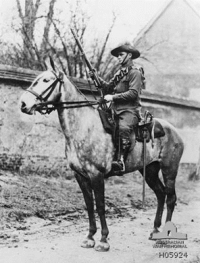
British P1912 Cavalry Officer's Sword
aussiesoldier replied to aussiesoldier's topic in Swords & Edged Weapons
SIGNIFICANT UPGRADE TO BIOGRAPHY Frederick Lowe JOHNSTON, SCOTTISH HORSE. Frederick Lowe Johnston was born 31st January 1895 the son of Frederick Williamson Johnston (1865 - 1936) and Catharine Johnston in Lanarkshire, Scotland. He joined the Scottish Horse Territorials, a cavalry regiment and was mobilised in March of 1915. He was in chosen from the ranks to undertake officer’s training and in December 1915, he was commissioned as 2nd Lieutenant Frederick Lowe Johnston, Scottish Horse and was given his cavalry sword upon graduation, probably by his parents. He was transferred to the 1st Battalion, The Royal Scots (The Royal Regiment) on the 12th of December 1915 and served with the infantry regiment in the Mediterranean in 1916. He was posted to Egypt in 1916 arriving in February 1916 and served with the Egyptian Expeditionary Force and may have seen action defending the canal at the Battle of Romani in August 1916. In 1917 he joined the 1st Battalion, The Royal Scots, at Salonika and engaged in various actions against the Bulgarian Army including the capture of Homondos in 1917, and the capture of the Roche Noir Salient, the passage of the Vardar River and the pursuit to the Strumica Valley in 1918. The battalion ended the war in Izlis, northwest of Doiran, Bulgaria. He was promoted to Lieutenant in August 1917 and as (Acting) Captain on the 1st of November, 1918, transferring to the Russian Civil War in December 1918 sailing from Salonika through the Dardanelles to the port of Batum in Russian Georgia, at the eastern end of the Black Sea. From there it moved eastwards to Tiblisi where it provided guards on vulnerable points in the town. On 3 March 1919 it moved by train to Baku on the Caspian Sea to assist in taking over the Russian Caspian fleet from Bolshevist crews. From Baku it returned to Tiblisi and returned to Edinburgh in May 1919, where (Acting) Capt. Johnston served as adjutant until December, 1923. (Acting) Captain Johnston, 1st Battalion, The Royal Scots, again embarked for imperial service, taking up garrison duties in Rangoon, in India in the early 1920’s. The 1st Battalion moved from Rangoon to Secunderabad in 1922, then to Aden in 1925. They finally returned to the UK in 1926, barracked at Maryhill in Glasgow, where they saw duty in the General Strike. He met and married Agnes Fyfe Hunter in 1926 in India. [Her father was Robert Hunter and mother was Jeanie Livingston. She was born on the 16th of September 1868 in Port Glasgow, Renfrewshire, Scotland. Her death is recorded as the 7th of January 1946 in Glasgow, Lanarkshire, Scotland.] They had one daughter, Marjorie McLeod Johnston in late 1926. Mother and daughter returned to Britain in April 1928 and returned to Glasgow, Scotland. He was promoted substantive Captain in 1926, Major in November 1937. He was posted to the Regiment’s Territorial battalions between 1932 and 1936, before returning to 1st Battalion, The Royal Scots, when it was deployed to serve in Palestine in the Arab Revolt, between 1936 to January 1939. when the battalion became part of the 4th Infantry Brigade, 2nd Infantry Division and returned to Britain. The 1936–1939 Arab revolt in Palestine, later came to be known as The Great Palestinian Revolt, was a nationalist uprising by Palestinian Arabs in Mandatory Palestine against the British administration of the Palestine Mandate, demanding Arab independence and the end of the policy of open-ended Jewish immigration and land purchases with the stated goal of establishing a "Jewish National Home". The dissent was directly influenced by the Qassamite rebellion, and the calling for a General Strike. Ben Gurion described Arab causes as fear of growing Jewish economic power, opposition to mass Jewish immigration and fear of the English identification with Zionism. The London Gazette, 25th April 1939, announces a ‘Mentioned in Dispatches’: ‘Maj. F. L Johnston, has been brought to notice by the General Officer Commanding the British Forces in Palestine and Trans-Jordan in recognition of distinguished services rendered in connection with the operations in Palestine during the period 1st April to 31st October, 1938 whilst serving with the 1st Battalion, The Royal Scots (The Royal Regiment). He was awarded the Order of the British Empire (Military Division) in December, 1939 (Edinburgh Gazette 1939) in recognition for his service in Palestine. He promoted (Acting) Lt. Colonel in September 1939, made substantive Lt. Colonel in June,1943 and (Acting) Brigadier General in March 1942. He served as Commanding Officer of the 157th Highland Light Infantry Brigade between March 1942 and November 1943. In 1942 to June 1944 the division was trained in mountain warfare yet was never used in the role. He then assumed command of the 45th Infantry Brigade between November 1943 and November of 1944. The brigade was a 2nd Line Territorial Army formation and served throughout the Second World War. It remained in the United Kingdom throughout the war. He was appointed an (Acting) Major General in May 1945 before reverting to his substantive rank of Brigadier General in July. In 1952, Frederick Lowe Johnston was appointed an Ordinary Commander of the Civil Division of the Most Excellent Order of the British Empire, CBE, possibly because of his service with the Territorial and Auxiliary Forces Associations, Edinburgh City, The Lothians and Peebles. He died on the 12th April, 1971 living his retirement in Bonnyrigg, Midlothian. -
My cavalry comment is linked to the shape of the handle and what looks like a straight blade for the most right hand officer. The 'negro' look - is it not possible? There were many 'gemischte Rasse' (mulato?) Germans in nth Germany, particularly the port cities. Happy to go along with your description.
-
This is a Pattern 1822/46 Light Cavalry sword. It is 103.5cm long. The 1845 blade design, outlined by Henry Wilkinson, was intended to be a more practical fighting blade than the pipe-backed blade which was used as regulation for officers' swords between 1821 and 1845/6. The slightly curved, polished steel blade is 82.6 cm long. The hilt and the grip is wire wrapped black leather. It is clearly made to withstand wear and use, however, unlike the standard pattern which had a knurled thumb rest, this example only has the outline of the border of where the knurling should be. Instead of a brass proof disk in the ricasso, there is only a circular outline of where one should be. I think this may indicate that it was a later production. Cavalry officers carried different pattern combat sabres akin to those of the trooper versions, but were often lighter in weight and had higher levels of finish and workmanship. The sword is a single fullered blade design, with crisp deep etching. The blade is straight and solid in the hilt. The hilt is officially described as a half basket, that is, a three bar, nickel steel design. The twisted triple silver wire is all in place, but the leather grip covering has lifted a bit from below the ferrule. The blade is engraved T H R 1854. (T H R – Thomas Hanson Radcliff) on one side and the bottom of the other side is marked "Parker Field & Sons, 233 Holborn London". Parker Field and Sons of London were the largest manufacturer by far for the police, prison service and customs. Thomas Hanson Radcliff was born in 1823 on Portsea Island, Hampshire. Little is known of his family, however, they had sufficient resources to purchase an Infantry Officer’s commission for him on the 3rd of April, 1840. Appointed as Infantry Ensign (@ £450). The purchase of officer commissions in the British Army was the practice of paying money to be made an officer in the cavalry and infantry regiments of the English and later British Army. By making a payment, a commission as an officer could be secured, avoiding the need to wait to be promoted for merit or seniority. It ensured that the officer class was largely filled by persons having a vested interest in maintaining the social and political status quo; thereby reducing the possibility of the military taking part in a revolution or coup. It ensured that officers had some private means and were less likely to engage in looting or pillaging or to cheat the soldiers under their command by engaging in profiteering using army supplies. Ensign Thomas Hanson Radcliff was commissioned and posted to the 1st Battalion, 2nd (The Queen’s Royal) Regiment of Foot in 1840. The battalion was stationed in the Desa Barracks, in Bombay. He was promoted Lieutenant on the 16th of August 1842. He saw combat service with the battalion in September, 1842 in Afghanistan, taking part in the Battle of / Retreat from Kabul, and was again in combat in 1844 in the Maratha Gwalior Campaign. He was eligible for the campaign medal and clasp. From 1852 until 1859 he was posted as Paymaster, 9th Regiment (Queen's Royal) Lancers, stationed at Umballah, in Bengal. Conforming to dress regulations, he purchased THIS 1822 light cavalry sword, using his wages to buy a personalised blade. He saw combat service again between May, 1857 and March, 1858, in the siege & capture of Delhi and the relief of Lucknow Delhi, although, how much of this was ‘combat’ is hard to define. He was however, eligible for the Medal with clasp. In January, 1860 he changed course yet again and was posted, as Paymaster Grade 3 to the Headquarters in Calcutta as paymaster to the Royal Artillery in India between 1860 and 1863. During this time he was promoted, Hon. Major, (10th January, 1860). Between 1864 and 1865 he was paymaster of the Military Train (Commissary) in India. Between 1866 and 1871 he was posted as Paymaster Grade 3 to the 3rd Battalion, The Prince Consort’s Own Rifle Brigade in Rawul Pindee. Major Thomas Radcliff returned to England, in January 1872, stationed in Portsmouth, with the 3rd Battalion, The Prince Consort’s Own Rifle Brigade. He retired that year to Portsea Island, Hampshire, England and died in April, 1873.
-
Hi, I collect and research military swords and then use them as teaching aids with secondary school history students. Recently I have taken to giving talks to antique and military sword collectors. It was my intention to keep the sword as part of my display and for the purposes stated. I have no intentions of selling and when I die I was going to give it to the local RSL as a representation of Korean War service. I can assure you it is well looked after and as you can see, I spent a great deal of time researching the background of its owner. I have been unable to discover his WW2 service beyond the bare bones of joining the RAAF and qualifying for air accident and fighter aircraft combat. It certainly wasn't a cheap purchase at auction and postage is horrendous from O/S at the moment. The exchange rate is a shocker. I am retired and this is my 'hobby'. I hope this helps. Yours George
-
Gentlemen, The following is the result of a great deal of research into a sword I purchased that did NOT fit into what I thought was correct, however, I believe I have scored a gem - something quite special and seemingly rare. Following the end of WWI and the creation of the post-war German Weimar Republic, Reichswehr Infantry Officers initially used an IOD-89 pattern Degen. The Degen was without the WRII grip cipher and with the Weimar pattern eagle without the Prussian crown, WRII cipher, sword or sceptre replacing the Imperial eagle on the guard. It is my belief that this sword is an early 1919 - late 1921-22 sword based upon the design of the eagle in the folding guard (charniett zum hochenklappen) [sorry if that is wrong]. As you can see the guard utilises the basic design of the Imperial Eagle and crown but does not have Kaiser Wilhelm's WR II monogram on the eagle's breast nor does this monogram appear on the hilt handle. The eagle does show the eagle holding the sword and sceptre of the state, and is shown wearing the state crown. This bird is extremely detailed throughout. The eagle, however, is not indicative of the Weimar version that commenced with the design shown and later changed to incorporate a new, neutral shield. This sword was beautifully crafted! The blade measures approx. 29” long with the overall length of the sword being approx. 34 ½”. Size 3 Officer’s sword. (Douglas, Swords of Germany, 1900/1945) On the side of the blade, there is an etching that reads "Paul Weyersburg & Co. Solignen" (active between 1905 – 1940). This sword was still listed in the Eickhorn sword sales catalogue in 1930 as their pattern No. 316. Who would have bought these swords? The vast majority of officers were taken over from the old army into the Reichswehr and therefore still had their IOD. Quite possibly, only new officers, or those that had lost their sword, would need to purchase. The Weimar Reichswehr was less than 100,000 and one would imagine that the need for new infantry officer’s sword was less than a 500 between December 1918 and February, 1922. The demand in the 14 months would, therefore, have been low. One should not forget that these early post-war years were tough times. Many officers and non-commissioned officers will surely have chosen the cost-effective version and converted the imperial IOD with a new hinge and handle without a WRII monogram. Why this low demand? Reichswehr officers were able to continue using their old sword, and there was no reason to buy a new one. Some new officers may have been conscious of tradition, that is, wanted to emulate the legacies of their "warlike" ancestors or their own past, if possible. However, in 1922 a new standard uniform or unitary sabre was introduced for the Reichswehr and retained for the Wehrmacht was introduced as; "Unitary sabre (order of February 17th, 1922, RWMin. No. 703 / 1.22.Jn.2 III. - HVBlatt 1922, No. 109)" of the Reichswehr.” These sabres were issued to the Portepee non-commissioned officers from 1922 and became the new model for officers in the Wehrmacht after 1933. Unfortunately, a distinction between the standard Reichswehr sabre and the 1933-45 sabre is difficult. So, I hope my research is close to the truth. It is the oNLY example of this sword and eagle combination I have been able to fit on the internet. Later examples displaying the Weimar Riechswehr eagle are shown but rare.
-
John Edgar Dent was born in Dec. 1863 at Hendon, Middlesex. He attended Sandhurst Military College in 1882 graduating as a Lieutenant. He was commissioned and posted 2nd Battalion, King’s Own Borderers, in Gibraltar in Mar, 1883. He would have purchased his first sword upon commissioning, a 1845 Infantry sword. The 2nd Battalion return to England in June, 1886 and was renamed King’s Own Scottish Borderers in 1887. In July, 1888, his battalion embarked for Egypt, joining the Suakin Field Force in Dec. 1888. Lt. Dent saw combat service in Soudan & Frontier. He fought at Gemaizah (Medal with Clasp & Khedive’s Star) and at Toski (Mentioned in Dispatches & 4th Class Medal of the Medjidie with Clasp). He was Wounded In Action in April, 1889 whilst part of the Upper Nile River Expedition. In 1890, the battalion embarked for India being barracked at Umbalia and at Meean Meer. In January of 1891 he was posted to the 1st Battalion and return to England, being promoted to Captain in Feb. 1891. Capt. Dent probably replaced his worn blade with a new pattern blade to commemorate his promotion. On the 1st Sept. 1894 he was posted to the 3rd Battalion in Dumfries, Scotland as Adjudant, HQ Coy. 3rd (Militia) Battalion. In Jan. of 1900 he was posted to the 1st Battalion and embarked for Sth Africa, 26th January. He saw combat service between 1900 to 1901 with the 1st Battalion served in the Boer War taking part in the action at Paardeberg, the Traansval & at the Battle of Rustenberg in October 1900, and in May the following year at Vlakfontein & Lambrechtfontein. He was eligible for the Queen’s South Africa Medal and the King’s South Africa Medal with Paarderberg, Johannesburg, and Cape Colony clasps. Capt. Dent return to England in 1901 and is promoted Major upon retirement in 1903. His sword is re-hilted with a Edward VII hilt, perhaps as a gift for service. He dies on the 18th Sept. 1906, single and well off.
-
Gentlemen, I had the pleasure of bringing this sword back to Australia from California(?????). Can't help but think it has some importance to the Royal Australian Navy. It is a Wilkinson sword and engraved with his initials and name; J R N Salthouse = LCDR (P) John Roy Norman Salthouse (RAAF) RAN Service – 3rd FEB 1948 TO MAY 1968 * John Roy Norman Salthouse was born on October 10, 1925, the son of Ms. Rosenwax and John. West Melbourne Victoria J R N Salthouse (438534) enlisted in the RAAF on 23 October, 1943, probably in Melbourne and obviously trained as a fighter pilot rising to the rank of Flight Lieutenant. There is a limited record of his WW2 service available. I have no clear idea if he saw combat in the later years/months of the war. Qualified for fighter combat and as an accident investigator. No evidence of a combat posting. When the British Pacific Fleet and its aircraft carriers came to Australia in the latter part of the war, approximately 24 RAAF pilots volunteered to transfer to the Royal Australian Navy Volunteer Reserve (RANVR) and these men subsequently served aboard Royal Navy aircraft carriers and at Royal Navy Air Stations established in Australia. These pilots have their Navy List marks X* P = General List Seaman Officer who was transferred primarily for aviation duties and is not qualified to undertake the full duties of an Officer of the Seaman Specialisation. He seems to be of a subsequent batch transferred to the Navy. Ft Lt Salthouse (RAAF) accepted a transfer to the Royal Australian Navy as a Lt (Pilot) on the 3rd of February, 1948. Initial service training was conducted at HMAS Cerebus and on the heavy cruiser, HMAS Australia. He was sent to Britain for a deck landing course in Britain at RNAS Heron at Yeovil and conversion to Sea Furies at RNAS St. Merryn.He sailed ‘home’ on the Stratheden arriving on 23 April, 1949. HMAS Sydney was commissioned into the RAN on 16th December, 1948. Sydney's maiden voyage saw the delivery of the first two squadrons operated by the Fleet Air Arm: 805 Squadron with Hawker Sea Furies, and 816 Squadron with Fairey Fireflies. The two squadrons operated as the 20th Carrier Air Group (CAG). Lt (P) Salthouse was posted to 808 Squadron at this time, 21st Carrier Air Group. During the Korean War, HMAS Sydney left Australia on 31st August, 1951, was deployed to Korean waters, with a wartime 20th Carrier Air Group of 805, 808, and 817 Squadrons embarked. (photo attached) The Fleet Air Arm operated in a strike, ground support, and escort role during the deployment. Promoted to Lieutenant Commander Appointed Commanding Officer of 805 Squadron on the 09 April 1951, as the 1st Australian Commanding Officer of a Royal Australian Navy Fleet Air Arm Squadron. (This came from a Fleet Air Arm site and can't be supported by his record, nor the Navy Lists) His squadron at war for 8 months as they conducted fighter and fighter bomber missions in the skies over the Korean Peninsula and the CAG was very highly regarded for its ground support accuracy. HMAS Sydney returned to Sydney on 22nd of February. he is relieved as CO 805Sq on the following day, 28th January, 1952. He made no further combat tours in his career. Continued to serve with the 805 & 808 Squadrons as Senior Pilot until April, 1955 HMAS Sydney, HMAS Melbourne, and NAS Albatross. Whilst test flying Fairfly WJ112 he crashed landed on 2nd of June, 1954, as a result of an engine fire and making an emergency wheels-up at Nowra Air Station, Albatross. LCDR Salthouse retrained as a helicopter pilot during September - December, 1955. Completes his Naval Watch Keeping Certificate on HMAS Anzac, January, 1956. I can only conclude that this was a prerequisite for promotion. Promoted to LtComder and takes Command of 723 Squadron on 3rd Feb 1957. 723 Sq. operates the following helicopters: 5 Sycamores and 2 Auster J5-G Autocars and two Firefly target tugs in May 1959, serving on HMAS Melbourne and HMAS Anzac. He commences a second tour as CO of this squadron on 24th July, 1959. Posted to Britain RN Air Station, (HMS Seahawk) Culdrose, Britain, February 1962 – September, 1963. Whirlwind Wessex helicopter conversion course (fully qualified 16 July, 1962) Posted as test pilot for Wessex Test Flight & Acceptance Program supervising the acceptance of all of the Wessex helicopters before they were sent to Australia. N7-200, the first RAN Wessex to be flown, at HMNAS Heron at Yeovil, (UK) on the 6th Sept. 1962 Posted 18 Aug, 1966 – 2 Nov, 1966 NAS Albatross Scout Helicopter conversion course Posted 723 Squadron, on 19th December, 1966, OIC of Survey Flight (Helicopters) He crashed again when on the 8th April, 1967. He was piloting the last Scout helicopter, WS102, operating off hydrographic survey ship, HMAS Moresby, mapping Australia's and New Guinea’s coastline and waterways, when he was forced to ditch in Wewak Harbour during take-off. LCDR JRN Salthouse retired from active service in May, 1968. Seems to have retired to Victoria with his second wife and daughter still only in his forties and worked as an insurance agent. He died on December 8, 1986, in Victoria, Australia, at the age of 61. The scabbard was in a very bad shape and there was considerable rust on the lower ends of the blade. I had purchased two replacement pieces on eBay from England but HMCustoms confiscated them ????? I ended up buying a cheap replacement RAN Naval sword, removed the chape and gave the sword to my 8 year old grandson. Not finished with the restoration but I love having another names sword. The sword knot is is poor shape but I don't want to replace it.
-
Chris, Don't know if this is true of all Infantry swords of the Bavarian Army but I own two very different I.O.S 1855 swords. (1) A fairly plain sword measuring 95.6 cm fitted with black metal fittings and a black scabbard made by Josef Vierheiligs of Munich, 1855 – 1887. I have assumed that this might well be purchased by a Unteroffizier mit Portpee or a cheap skate officer! (2) A more elaborate Löwekopf Infanterie Offizier Säbel, 94 cm long with brass fittings and a black scabbard showing no makers' mark. Would one expect officer's swords to usually be shorter or is this just to suit a shorter officer.
-
Knowledgeable Colleagues. I have been pondering these two problems for a long while. 1. Are all Kingdom of Württemberg I OD89 engraved with the royal cipher of King Karl I? Did it eventually change in the C20th? 2. Is a old German Gothic inscription challenge. I can not find a German word that starts with these four letters in either archaic German dictionaries or a more modern dictionary. Part of the translation is reasonably easy (yes that's a bold statement). 'Ginj. Freiw.D.Nebelung' = Ginj. Free Volunteers of Nebelung (Forest?) If you are able to help, whta does the abbreviated term Ginj. stand for? I look forward with some hope to your responses. Thanks, George




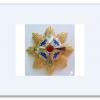




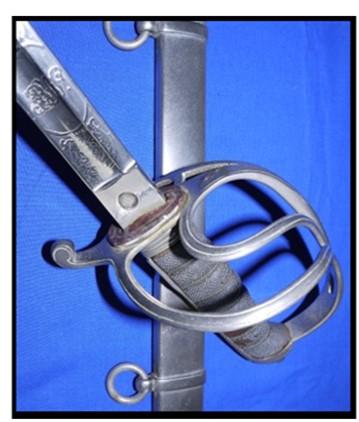
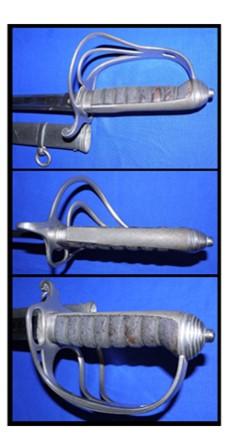






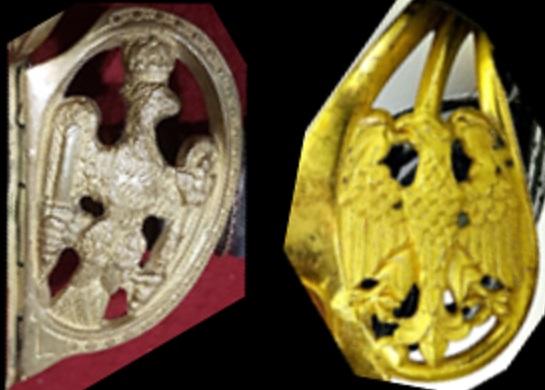
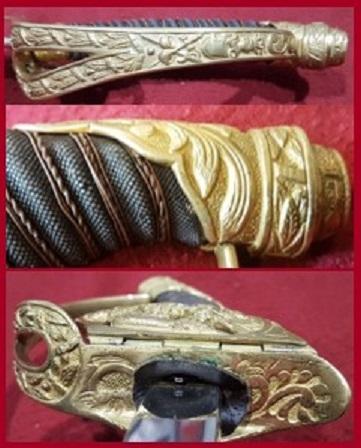
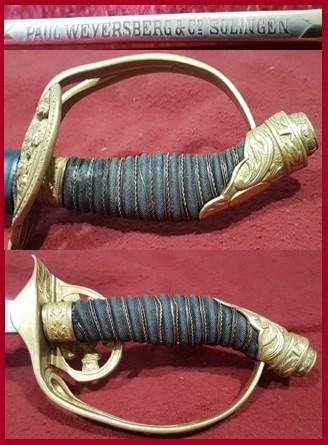
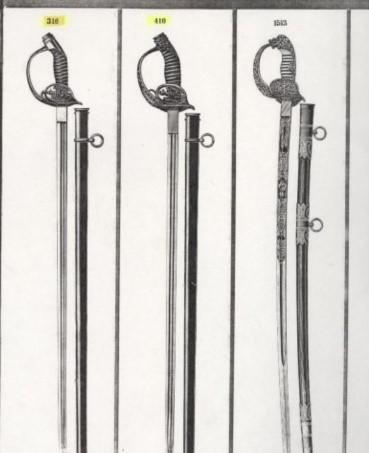




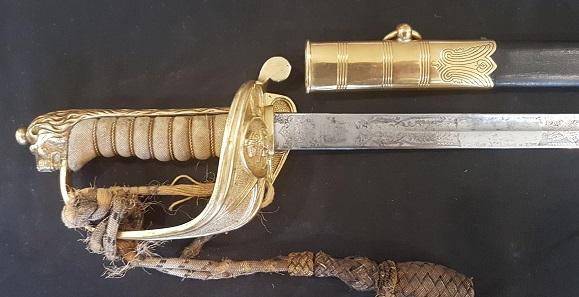
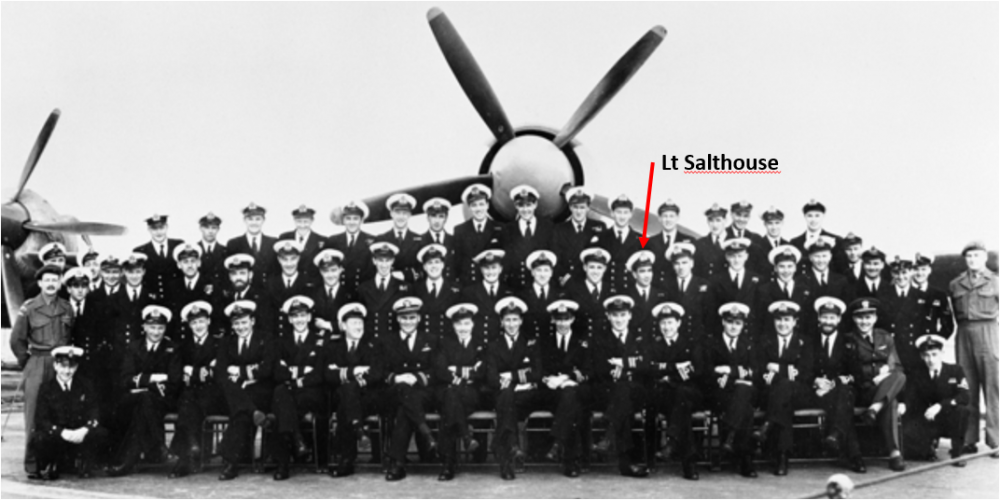
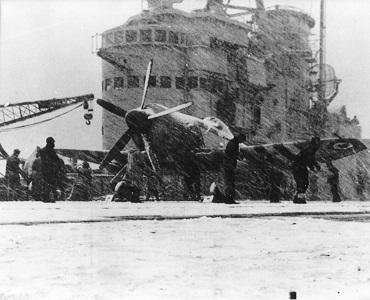
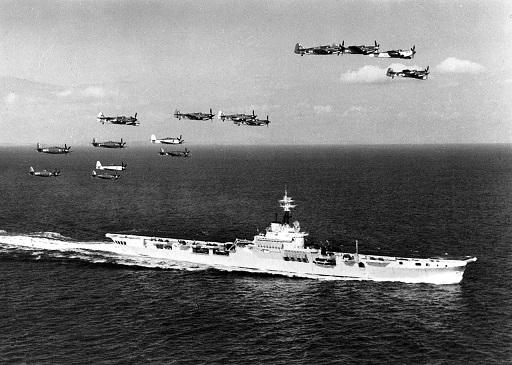
posinginfrontofaSycamore849..png.0ec3a4b7de2b354285a4ec80d6e8afcc.png)